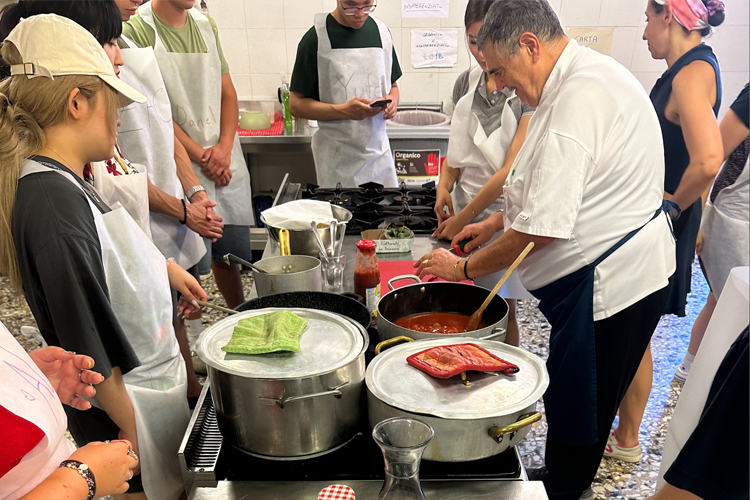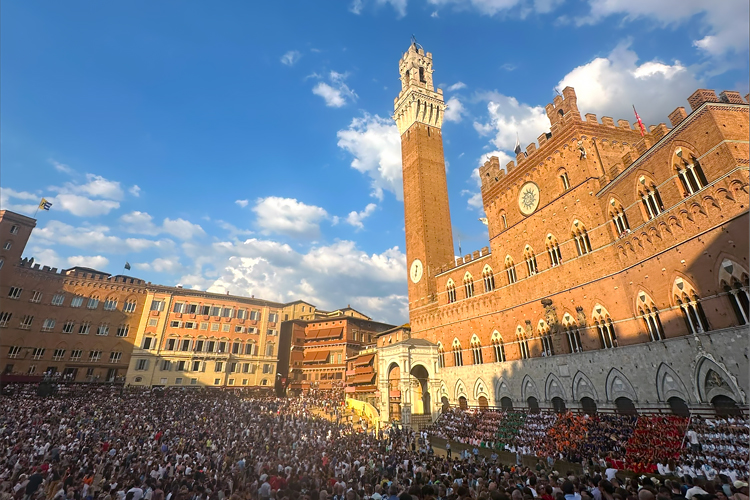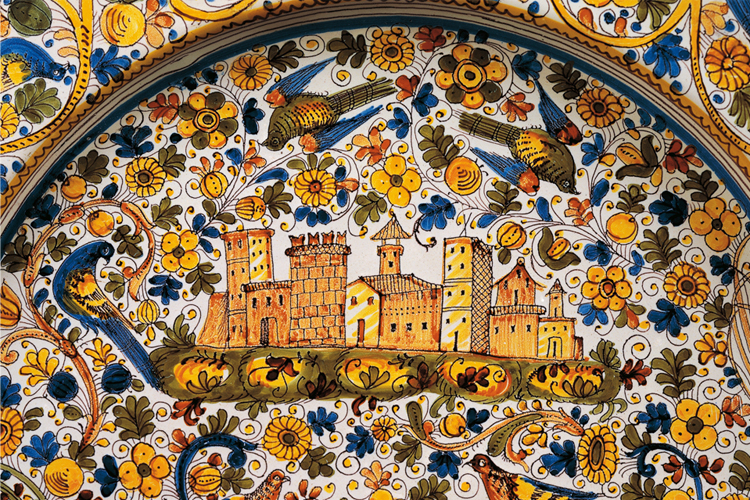There’s an old Italian proverb: A tavola non si invecchia mai, which translates to "You never grow old at the dinner table."
A group of 30 students preserved their youth this summer, taking a four-week anthropology course through U of T’s Summer Abroad program called Italian Regional Foodways and Culture.
“We journeyed through diverse regions of Italy, diving into the heart of its cuisine and culture,” says Julia Kozlowski, a fourth-year member of Victoria College completing a combined master’s degree in education. “Every stop was a sensory adventure, and it brought the Italian kitchen to life in a way that no textbook ever could.”
“This was far more than a cooking course,” says Anne Urbancic, the former Mary Rowell Jackman Professor of Humanities at Victoria College who led the course.
“This was an anthropology course, so we talked about history. We talked about issues in Italian food and foodways, and how it's changing as a result of climate change, the European Union, and from political pressures and tensions around the world.”

To better understand butchering trends, the students met with one of Tuscany’s most popular butchers and chefs, Dario Cecchini, known internationally for his “nose to tail” approach.
“He welcomed the students into his butcher shop and told them about his philosophy of eating where nothing is wasted, you respect the animal and you don't have huge farms where animals are raised almost mechanically,” says Urbancic.
“He’s become a celebrity chef and he's also teaching,” she adds, noting that one of his pupils is Chris Terpstra, who owns Alimentari Italian Grocery in Toronto’s Roncesvalles neighbourhood. “Others have now opened up shops around the world with a similar attitude towards clean, fairly produced Italian food.”
The class also learned about famous dishes upon which Italian cuisine is served, visiting the town of Deruta. This medieval town in central Italy is known for producing colourful maiolica (painted tin-glazed) pottery dating back to the 15th century.
The town currently boasts over 200 ceramic workshops with artisans using techniques passed down from generation to generation. And its history is easy to spot, with ruins of ancient ceramic kilns throughout the area.
Moving from ceramics to sweets, the class savoured chocolates from the Perugina Baci chocolate factory in the town of Perugia, also in central Italy. Enjoying chocolate treats sold all over the world, this facility is the largest of parent company, Nestlé's nine operations in Italy.
“We didn’t shy away from the fact that it's a factory,” says Urbancic. “You can get this image of Italy that everything is made by hand, but it’s not.”

Other field trips and lessons included learning about making organic wine and pasta, a taste of Italy’s finest coffee in Florence, and a sampling of street food in the coastal city of Bari.
But what’s a tour of Italy without cooking? The students put on their aprons and learned how to prepare traditional Tuscan dishes.
“They worked with Tuscan chefs and produced dinner from scratch,” says Urbancic. “That included an antipasto, a pasta, an entrée and then tiramisu for dessert.
“The chefs didn’t speak English, so the students had to negotiate the instructions. They were doing it all themselves in a language that is not their own. Some of them have other food cultures that are completely foreign to what they were learning.”
While cooking, they learned interesting culinary traditions, like why Tuscan bread doesn’t have salt in it. This goes back to the Middle Ages when there was a salt tax. And why a soffritto — a blend of vegetables, herbs and spices such as celery, garlic, carrots and tomatoes is a must for most Italian sauces and soups.
One of the course’s most popular excursions didn’t focus on food, but culture, with the students traveling to Matera — a small city located in the arch of Italy’s boot.
“It’s a magical city, it’s absolutely fascinating,” says Urbancic. “Matera is a place where, up until the 1950s, people actually lived in stone caves.”

“It was called the ‘shame of Italy.’ And the government stepped in and rehoused a lot of the people. But young people who are there today want to show that Matera has its place in modern Italy. They're educated and professional, and they’ve started a robust tourism industry.”
“Matera stands out as something truly special,” says Kozlowski. “We explored a charming, historic winery where we had a one-of-a-kind tour and tasting experience, followed by a visit to an olive oil museum where the craftsmanship behind this Italian staple came to life. Wandering through its ancient streets, I felt fully immersed in the richness of Italy’s history and culture.”
It’s experiences and reactions like Kozlowski’s that make Summer Abroad courses so enriching and meaningful for Urbancic.
“I cannot tell you how much I'm a believer of studying abroad,” she says.
“It's great to read a textbook, but when you go to another culture, you have to negotiate language,” she says. “You have to converse. You put your cell phone down and talk, and you have to listen to the other person.
“To do that is to gain respect. It's to gain knowledge. It's to gain an appreciation of someone else, and that someone else is gaining an appreciation of you. It gives students a real sense of confidence, knowing they can do this, they can get around, they can commit to another culture and benefit from that.”

“This course deepened my appreciation for travel and the power of meaningful, shared experiences,” says Kozlowski.
“From making pasta in intimate family kitchens to listening to café owners share their life stories, to discovering the rustic beauty of regional Italian cooking and traditions, I gained a profound understanding of Italian cuisine. I learned about the humble yet rich tradition of cucina povera — a simple yet deeply flavourful way of cooking that honours the land and its history. Every bite carried with it a story of resilience, creativity and cultural pride.”
For Urbancic, this course was especially enjoyable, as it was her last assignment before retiring after a distinguished teaching career at U of T that spanned almost 50 years.
“It was just the best way to retire,” she says. “I just loved the students. I couldn’t have asked for anything better.”


